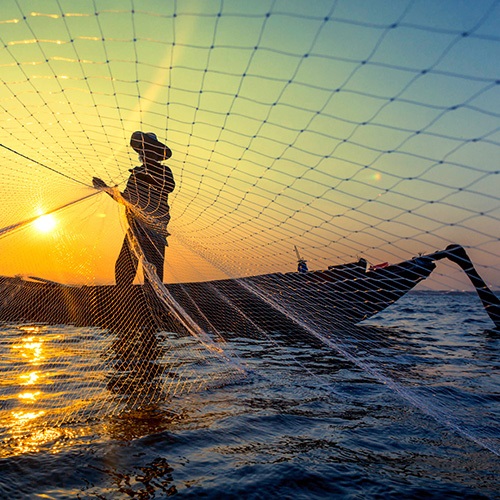1. A third of fish stocks are still being overfished
It's disappointing that the proportion of stocks being overfished continues to rise - to more than three times the level half a century ago. In 2017, less than two thirds of stocks were fished at biologically sustainably levels.Fish stocks that are allowed to deteriorate through poor management and weak regulation lead to less food from the ocean and more harm to the long-term survival of ecosystems. Overfished stock represents more than 34% of all stocks but only produce 22% of landings. In contrast, intensively managed fisheries generally see a reduction in average fishing pressure and an increase in stock biomass.
We need to see these successful management polices replicated around the world, with governments rigorously implementing the FAO Code of Conduct for Responsible Fisheries. This means establishing and reinforcing local scientific capacity, establishing science-based management regimes, clamping down on illegal, unregulated and unreported fishing and ending harmful subsidies. We want to put all fisheries on a Pathway to Sustainability.
2. Better fisheries management is the key to alleviating poverty and ending hunger for millions
Fish provides half the world’s population with almost 20% of their average intake of animal protein. In some countries, including Bangladesh, Cambodia, Gambia, Ghana, Indonesia, Sierra Leone and Sri Lanka, the dependency on fish for protein is over 50%.
Under these circumstances, ensuring that everyone benefits from their nation’s natural resources requires fish stocks and industry to be managed fairly.
It’s important to bear in mind that half of the nearly 60 million people working directly in seafood production are women. They are often the most poorly paid, hold informal roles and remain under-recognised in the sector. This situation, and others resulting in poverty and reduced social mobility, are unlikely to change where natural resources are under strong harvesting pressure and fishing practices are unsustainable.
Only when nations have well managed fisheries and sustainable fish stocks will their communities thrive and use the full potential of their natural and human resources.
Ensuring all seafood is sustainably sourced is therefore an environmental and humanitarian imperative. It is unlikely that target 14.4 of the UN's Sustainable Development Goals (SDGs) - to end overfishing by 2020 - will be achieved. But SDG 14 (Life Below Water) and SDG 2 (Zero Hunger) are not out of reach by 2030, if we put our minds to it.
It is in every county’s interest to manage fish resources well and improve regional and global food security. This is obviously more challenging for some, with a large disparity between fish stocks in the Global North and South. Our Global Accessibility Program for Small Scale Fisheries and Fisheries in the Global South aims to ensure that MSC Program benefits are accessible to all fisheries, regardless of size or region.
Under these circumstances, ensuring that everyone benefits from their nation’s natural resources requires fish stocks and industry to be managed fairly.
It’s important to bear in mind that half of the nearly 60 million people working directly in seafood production are women. They are often the most poorly paid, hold informal roles and remain under-recognised in the sector. This situation, and others resulting in poverty and reduced social mobility, are unlikely to change where natural resources are under strong harvesting pressure and fishing practices are unsustainable.
Only when nations have well managed fisheries and sustainable fish stocks will their communities thrive and use the full potential of their natural and human resources.
Ensuring all seafood is sustainably sourced is therefore an environmental and humanitarian imperative. It is unlikely that target 14.4 of the UN's Sustainable Development Goals (SDGs) - to end overfishing by 2020 - will be achieved. But SDG 14 (Life Below Water) and SDG 2 (Zero Hunger) are not out of reach by 2030, if we put our minds to it.
It is in every county’s interest to manage fish resources well and improve regional and global food security. This is obviously more challenging for some, with a large disparity between fish stocks in the Global North and South. Our Global Accessibility Program for Small Scale Fisheries and Fisheries in the Global South aims to ensure that MSC Program benefits are accessible to all fisheries, regardless of size or region.
3. There is no such thing as a sustainable species, only sustainable stocks
Tuna remains a firm favourite with consumers around the world and the global catch of all tuna species combined is at an all-time high. But there are big variations in what that means for the 23 known stocks of the 5 distinct species.
Much of the expansion has come from growing catches in the Western and Central Pacific, where intensive efforts to manage key stocks are keeping them at biologically sustainable levels. Skipjack tuna is being well managed and is now the world’s third most caught species at over 3 million tonnes per year. In contrast, the highly prized bluefin tuna continues to be caught despite the status of the different stocks being disputed.
The proportion of tuna from overfished stocks has dropped by 10 percentage points in just two years, which is real progress. But currently a third of the nearly 8 million tonnes caught each year are unsustainable, so it still pays to check the label when you buy.
Much of the expansion has come from growing catches in the Western and Central Pacific, where intensive efforts to manage key stocks are keeping them at biologically sustainable levels. Skipjack tuna is being well managed and is now the world’s third most caught species at over 3 million tonnes per year. In contrast, the highly prized bluefin tuna continues to be caught despite the status of the different stocks being disputed.
The proportion of tuna from overfished stocks has dropped by 10 percentage points in just two years, which is real progress. But currently a third of the nearly 8 million tonnes caught each year are unsustainable, so it still pays to check the label when you buy.
4. Seafood production is at an all-time high, but consumption is growing faster than ever
We’re all, on average, eating over 20 kilograms of seafood per year, with consumption outpacing population growth and growing faster than our appetite for meat.
Wild fish capture now stands at over 96 million tonnes a year, up 14% since 1990. But consumption has risen by a staggering 122%, with the difference made up by 82 million tonnes of aquaculture (fish farming). The proportion of fish that is certifiably sustainable or responsibly sourced is also higher than ever.
Nevertheless, to protect our oceans, we need to make sure that fish feed produced from marine catch is sustainable too. There has been a decrease in the volume of unsustainable catch of species traditionally targeted for fishmeal, but it’s difficult to take comfort from this without knowing whether it’s a result of better practices (such as increased use of by-products that would otherwise be wasted) or declining catches from overfished stocks.
Wild fish capture now stands at over 96 million tonnes a year, up 14% since 1990. But consumption has risen by a staggering 122%, with the difference made up by 82 million tonnes of aquaculture (fish farming). The proportion of fish that is certifiably sustainable or responsibly sourced is also higher than ever.
Nevertheless, to protect our oceans, we need to make sure that fish feed produced from marine catch is sustainable too. There has been a decrease in the volume of unsustainable catch of species traditionally targeted for fishmeal, but it’s difficult to take comfort from this without knowing whether it’s a result of better practices (such as increased use of by-products that would otherwise be wasted) or declining catches from overfished stocks.
5. A third of the global seafood harvest is wasted
About 88% of the 179 million tonnes of fish caught or grown are used for direct human consumption. Most of the rest is used to produce fishmeal and fish oil, but some ends up as pet food, bait, animal feed or in pharmaceuticals.
But it’s estimated that a third of fish is lost or wasted each year, as it travels along the supply chain. It’s such a problem that halving it by 2030 is a target of the Sustainable Development Goals. Up to 70% of processed fish may end up as by-product, although this is not always thrown away and might be used as feed in aquaculture or animal food. Preserving fish quality requires a reliable continuous unbroken supply chain that keeps the product within a certain temperature range with good hygiene.
Disappointingly, it is wealthier countries with better infrastructure that are often the most wasteful – up to half of the fish in North America and Oceania never gets eaten. In the Global South, fish loss is mainly due to a lack of reliable and affordable water, ice and cold storage and refrigerated transportation.
Many people around the world who rely on fish are not ready or able to engage with market driven ecolabelling schemes. But for those that are, fisheries around the world are choosing to voluntarily adhere to the MSC Fisheries Standard, which is based on the FAO Code of Conduct, and working with partners who meet the MSC Chain of Custody Standard.
Read the full report - FAO: The State of World Fisheries and Aquaculture 2020
But it’s estimated that a third of fish is lost or wasted each year, as it travels along the supply chain. It’s such a problem that halving it by 2030 is a target of the Sustainable Development Goals. Up to 70% of processed fish may end up as by-product, although this is not always thrown away and might be used as feed in aquaculture or animal food. Preserving fish quality requires a reliable continuous unbroken supply chain that keeps the product within a certain temperature range with good hygiene.
Disappointingly, it is wealthier countries with better infrastructure that are often the most wasteful – up to half of the fish in North America and Oceania never gets eaten. In the Global South, fish loss is mainly due to a lack of reliable and affordable water, ice and cold storage and refrigerated transportation.
Many people around the world who rely on fish are not ready or able to engage with market driven ecolabelling schemes. But for those that are, fisheries around the world are choosing to voluntarily adhere to the MSC Fisheries Standard, which is based on the FAO Code of Conduct, and working with partners who meet the MSC Chain of Custody Standard.



